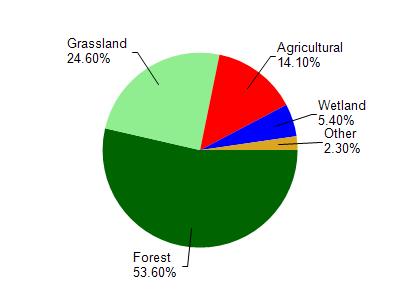Iowa
No
No
No
Fish and Aquatic Life
Overview
Marsh Creek - Avoca Lake is an enlargement of Marsh Creek that drains to the Wisconsin River by Avoca. A rare aquatic species has been found in Marsh Creek.
From: Ripp, Coreen, Koperski, Cindy and Folstad, Jason. 2002. The State of the Lower Wisconsin River Basin. PUBL WT-559-2002. Wisconsin Department of Natural Resources, Madison, WI.
Date 2002
Author Cynthia Koperski
Historical Description
Marsh Creek - Mouth location T8N RIE Section 3 -2, Surface area = 10.8 acres, Length = 8.8 miles, Gradient = 22.8 feet per mile, Total alkalinity 255.0 mg/l, Volume of flow = 15..9 cfs.
Marsh Creek begins on the escarpment of the Southwestern Uplands and flows northerly until it reaches the Wisconsin River floodplain and then turns north westward until it reaches the Wisconsin River. The stream widens about midway in its length in the form of Avoca Lake which has recreational assets. Morrey Creek (Underwood) is its prinipal tributary and enters about three-fourths of a mile from the mouth. Its principal water source is seepage moving downslope to the Wisconsin River. Flooding is common during the spring thaw when the Wisconsin River overflows its banks. Most of its drainage basin is farmed although much of its length in the Wisconsin River floodplain is bordered by swamp hardwoods. Its sport fishery from its mouth up to and including Avoca Lake includes northern pike, walleyes; smallmouth and largemouth bass;
channel catfish, bluegills, crappies and bullheads. Other species most likely present are white suckers, buffalo, quillback carpsuckers, carp and redhorse. The usual forage fishes are also found here and in the sections above Avoca Lake. Aquatic game assets are many and consist of beaver, muskrats, otter, mink and raccoons in the lower sections. Many varieties of ducks and some Canada geese can be found in the basin throughout the year, especially during the spring and fall migrations. Public lands and access are available from the Avoca public hunting and fishing grounds which are managed by the Department of Natural Resources.
From: Piening, Ronald and Threinen, C.W., 1968. Lake and Stream Classification Project. Surface Water Resources of Iowa County, Wisconsin Department of Natural Resources, Madison, WI.
Date 1968
Author Surface Water Inventory Of Wisconsin
Condition
Wisconsin has over 84,000 miles of streams, 15,000 lakes and milllions of acres of wetlands. Assessing the condition of this vast amount of water is challenging. The state's water monitoring program uses a media-based, cross-program approach to analyze water condition. An updated monitoring strategy (2015-2020) is now available. Compliance with Clean Water Act fishable, swimmable standards are located in the Executive Summary of Water Condition in 2018. See also the 'monitoring and projects' tab.
Management Goals
Wisconsin's Water Quality Standards provide qualitative and quantitative goals for waters that are protective of Fishable, Swimmable conditions [Learn more]. Waters that do not meet water quality standards are considered impaired and restoration actions are planned and carried out until the water is once again fishable and swimmable
Management goals can include creation or implementation of a Total Maximum Daily Load analysis, a Nine Key Element Plan, or other restoration work, education and outreach and more. If specific recommendations exist for this water, they will be displayed below online.
Monitoring
Monitoring the condition of a river, stream, or lake includes gathering physical, chemical, biological, and habitat data. Comprehensive studies often gather all these parameters in great detail, while lighter assessment events will involve sampling physical, chemical and biological data such as macroinvertebrates. Aquatic macroinvertebrates and fish communities integrate watershed or catchment condition, providing great insight into overall ecosystem health. Chemical and habitat parameters tell researchers more about human induced problems including contaminated runoff, point source dischargers, or habitat issues that foster or limit the potential of aquatic communities to thrive in a given area. Wisconsin's Water Monitoring Strategy was recenty updated.
Grants and Management Projects
| Project Name (Click for Details) | Year Started |
|---|
|
|
Monitoring Projects
| WBIC | Official Waterbody Name | Station ID | Station Name | Earliest Fieldwork Date | Latest Fieldwork Date | View Station | View Data |
|---|
| 1219900 | Marsh Creek | 10031525 | Avoca Lake Deep Hole | 8/12/2010 | 10/28/2024 | Map | Data |
|

Watershed Characteristics
Marsh Creek is located in the Otter and Morrey Creeks watershed which is 198.69 mi². Land use in the watershed is primarily forest (53.60%), grassland (24.60%) and a mix of agricultural (14.10%) and other uses (7.70%). This watershed has 437.57 stream miles, 351.55 lake acres and 5,785.74 wetland acres.
Nonpoint Source Characteristics
This watershed is ranked Not Ranked for runoff impacts on streams, Low for runoff impacts on lakes and High for runoff impacts on groundwater and therefore has an overall rank of High. This value can be used in ranking the watershed or individual waterbodies for grant funding under state and county programs.However, all waters are affected by diffuse pollutant sources regardless of initial water quality. Applications for specific runoff projects under state or county grant programs may be pursued. For more information, go to surface water program grants.